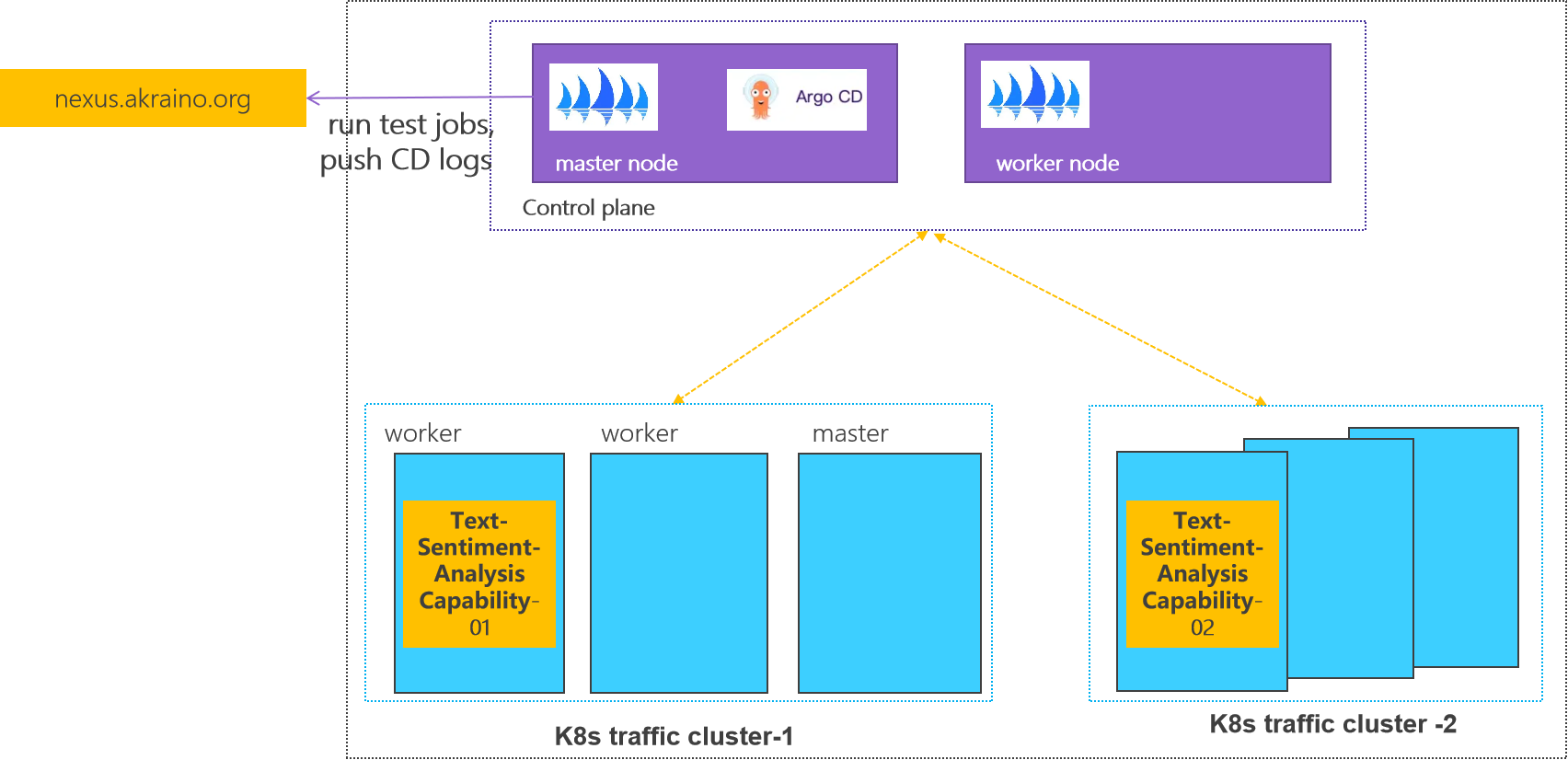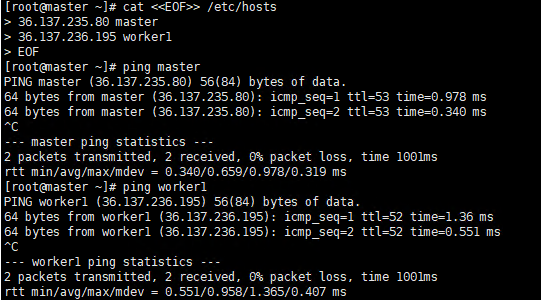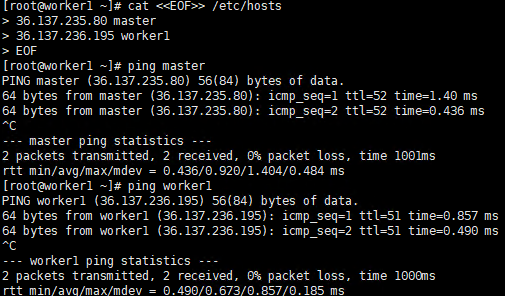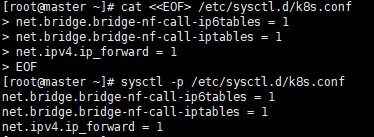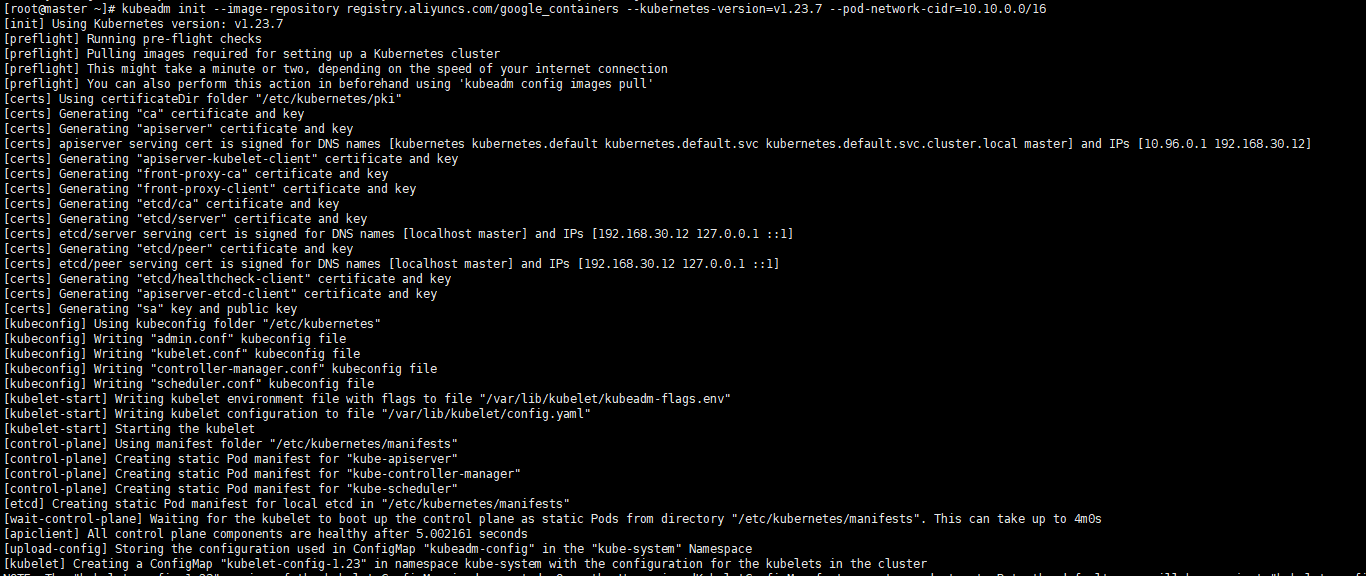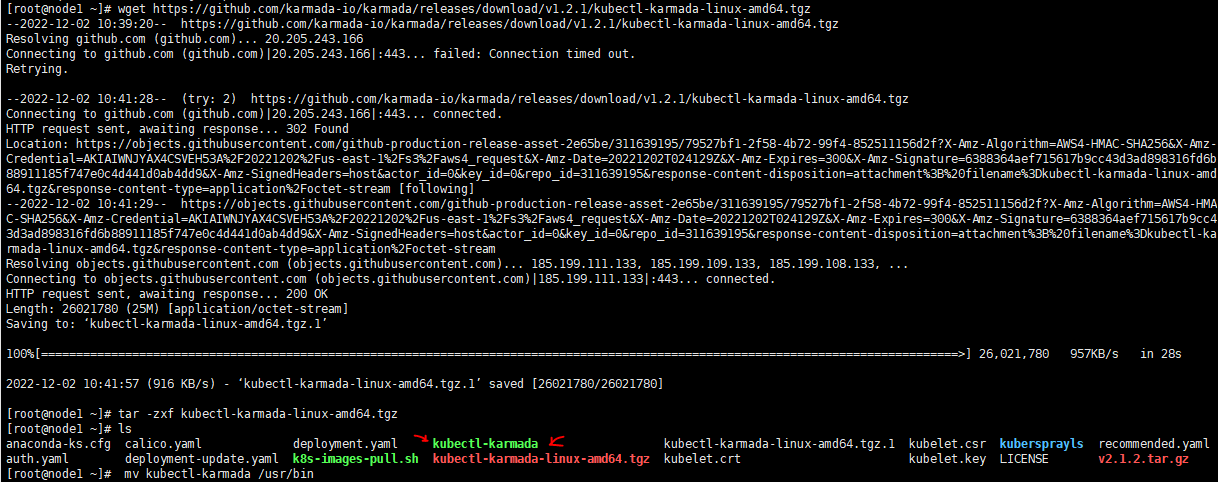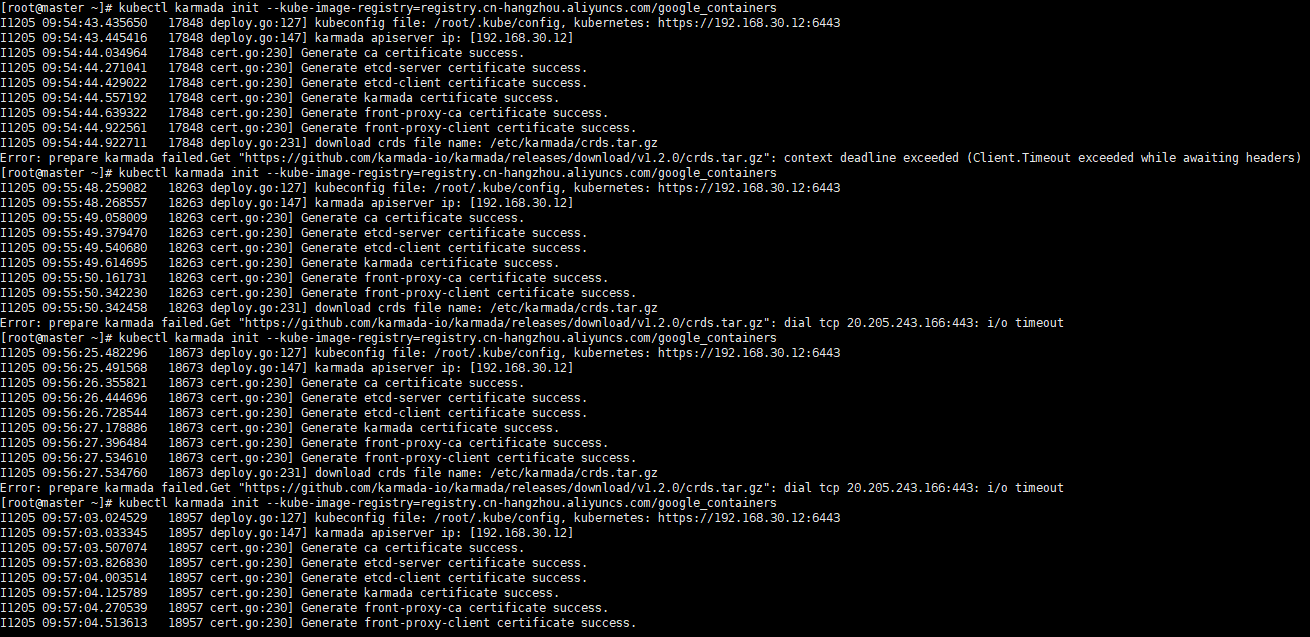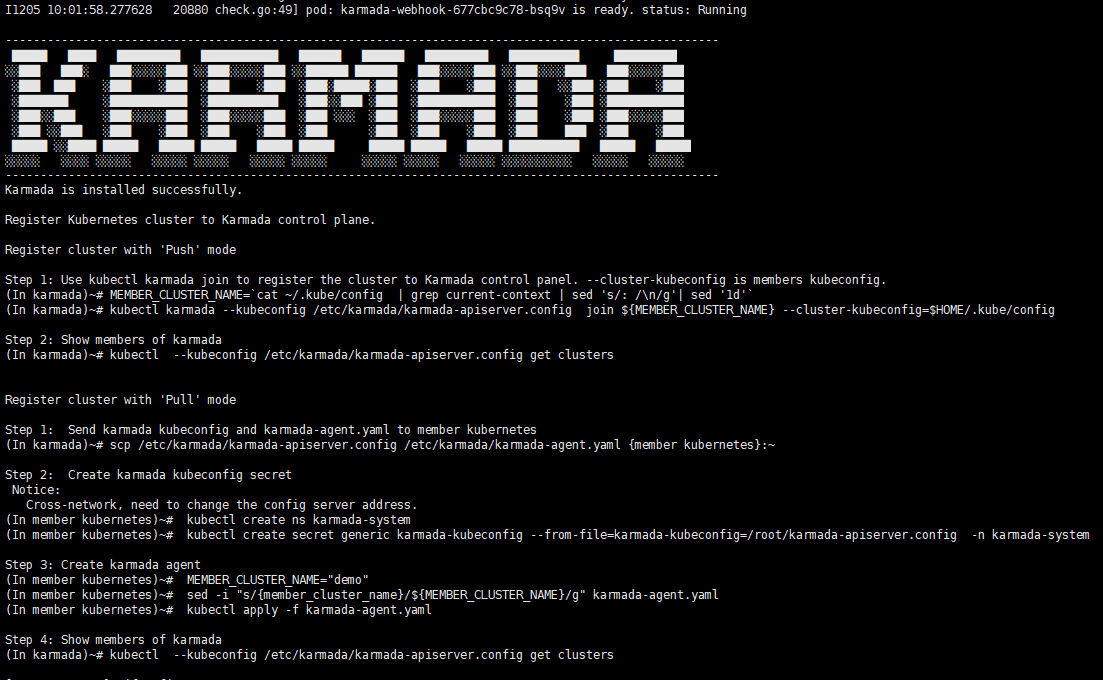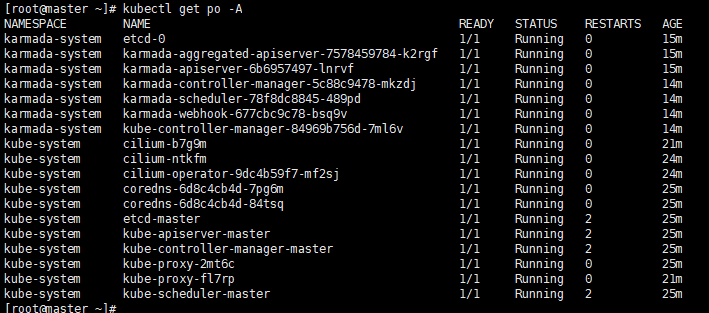| Table of Contents |
|---|
@MIGU 补充应用安装相关部分
@huawei 补充控制面相关部分
Introduction
How to use this document
Deployment Architecture
This document describes steps required to deploy a sample environment and test for CFN (Computing Force Network) Ubiquitous Computing Force Scheduling Blueprint.
Deployment Architecture
Control plane: one k8s cluster is deployed in private lab.
Traffic plane: two K8s clusters are deployed in private lab.
Pre-Installation Requirements
...
kubeadm-1.23.7
kubectl-1.23.7
N/A
- Database Perequisites
schema scripts: N/A
...
0 Environmental description
Two centos At least two CentOS machines are required, one as the master node and the other as the worker node. The installed k8s version is 1.23.7.
There will be a comment like #master in front of each bash command, which is used to indicate which type of machine the command is used on. If there is no comment, the bash command needs to be executed on both types of machines
This document contains the operation and execution process, you can compare the screenshots of the document during the installation process.
1 Basic environment preparation
Both master node and worker node need to execute.
Preparing the The main content is to prepare the basic environment to ensure the normal execution of subsequent operations.
...
Confirm that the operating system of the current machine is CentOS 7 .
Execute command:command
| Code Block | ||||||
|---|---|---|---|---|---|---|
| ||||||
cat /etc/redhat-release |
Execute screenshot:screenshot
1.2
...
Set hostname
If the name is long, it is recommended to use a combination of letters and dashes, such as "aa-bb-cc", here directly set to master and worker1.
Execute command
| Code Block | ||||||
|---|---|---|---|---|---|---|
| ||||||
# master hostnamectl set-hostname master hostnamectl # worker hostnamectl set-hostname worker1 hostnamectl |
Execute screenshot:screenshot
The changed host name needs to take effect after reboot.
Execute command
| Code Block | ||||||
|---|---|---|---|---|---|---|
| ||||||
reboot |
1.3 Set address mappinmapping
Set address mapping, and test the network.
Execute command
| Code Block | ||||||
|---|---|---|---|---|---|---|
| ||||||
cat <<EOF>> /etc/hosts
${YOUR IP} master
${YOUR IP} worker1
EOF
ping master
ping worker1 |
Execute screenshot
1.4 Turn off firewall, selinux and swap
Execute command
| Code Block | ||||||
|---|---|---|---|---|---|---|
| ||||||
systemctl stop firewalld
systemctl disable firewalld
setenforce 0 sed -i "s/^SELINUX=enforcing/SELINUX=disabled/g" /etc/selinux/config
swapoff -a
sed -i 's/.*swap.*/#&/' /etc/fstab |
Execute screenshot
1.5 Download the new yum source
Execute command
| Code Block | ||||||
|---|---|---|---|---|---|---|
| ||||||
rm -rf /etc/yum.repos.d/* ;wget ftp://ftp.rhce.cc/k8s/* -P /etc/yum.repos.d/
ls /etc/yum.repos.d/ |
Execute screenshot
...
1.6 Set
...
iptables
Execute command
| Code Block | ||||||
|---|---|---|---|---|---|---|
| ||||||
cat <<EOF> /etc/sysctl.d/k8s.conf net.bridge.bridge-nf-call-ip6tables = 1 net.bridge.bridge-nf-call-iptables = 1 net.ipv4.ip_forward = 1 EOF sysctl -p /etc/sysctl.d/k8s.conf |
Execute screenshot
1.7 Make sure the time zone and time are correct
Execute command
| Code Block | ||||||
|---|---|---|---|---|---|---|
| ||||||
timedatectl set-timezone Asia/Shanghai systemctl restart rsyslog |
Execute screenshot
2 Install docker
Both master node and worker node need to execute.
The main content is to install docker-ce, and configure the cgroup driver of docker as systemd, confirm the driver.
2.1
...
Uninstall old docker
Execute command
| Code Block | ||||||
|---|---|---|---|---|---|---|
| ||||||
yum -y remove docker docker-client docker-client-latest docker-common docker-latest docker-latest-logrotate docker-logrotate docker-engine docker-ce docker-ce-cli |
Execute screenshot
2.2
...
Install docker
Execute command
| Code Block | ||||||
|---|---|---|---|---|---|---|
| ||||||
yum -y install docker-ce |
Execute screenshot
2.3 Set docker to boot and confirm docker status
Execute command
| Code Block | ||||||
|---|---|---|---|---|---|---|
| ||||||
systemctl enable docker systemctl start docker systemctl status docker |
Execute screenshot
2.4 Configure the driver of docker's cgroup
The driver of docker's cgroup needs to be consistent with that of kubelet. It is recommended to set it to systemd.
Execute command
| Code Block | ||||||
|---|---|---|---|---|---|---|
| ||||||
docker info | grep -i cgroup |
Check the current configuration, if it is the system in the figure below, skip the follow-up and go directly to the third section
Execute screenshot
If it is cgroupfs, add the following statement
Execute command
| Code Block | ||||||
|---|---|---|---|---|---|---|
| ||||||
vim /etc/docker/daemon.json
# add this
{
"exec-opts": ["native.cgroupdriver=systemd"]
} |
Restart to check for changes
Execute command
| Code Block | ||||||
|---|---|---|---|---|---|---|
| ||||||
systemctl daemon-reload && systemctl restart docker docker info | grep -i cgroup |
3 Install k8s basic components
Both master node and worker node need to execute.
The main content is to install the 1.23.7 version of the component kubeadm kubectl kubelet
3.1
...
Check kubeadm kubectl kubelet
If it is the version inconsistent, you need to uninstall it through yum remove ${name}.
Execute command
| Code Block | ||||||
|---|---|---|---|---|---|---|
| ||||||
yum list installed | grep kube |
Execute screenshot
3.2 Install kubelet kubeadm kubectl version 1.23.7
Execute command
| Code Block | ||||||
|---|---|---|---|---|---|---|
| ||||||
yum -y install kubelet-1.23.7 kubeadm-1.23.7 kubectl-1.23.7 |
Execute screenshot
3.3 Verify installation
Execute command
| Code Block | ||||||
|---|---|---|---|---|---|---|
| ||||||
kubelet --version kubeadm version kubectl version |
Execute screenshot
4 Initialize the master
Execute only on the master node.
The main content is to pull the image of version 1.23.7, initialize the master node, and configure the calico cilium network plug-in plugin for the master node
4.1 Pull the k8s image Pull the k8s image
Execute command
| Code Block | ||||||
|---|---|---|---|---|---|---|
| ||||||
# master kubeadm config images list --kubernetes-version=v1.23.7 |sed -e 's/^/docker pull /g' -e 's#k8s.gcr.io#registry.aliyuncs.com/google_containers#g' |sh -x docker pull registry.aliyuncs.com/google_containers/coredns:v1.8.6 docker images |
Execute screenshot
Please make sure that the above 7 images have been pulled down
4.2 Init master
Execute command
| Code Block | ||||||
|---|---|---|---|---|---|---|
| ||||||
# master kubeadm init --image-repository registry.aliyuncs.com/google_containers --kubernetes-version=v1.23.7 --pod-network-cidr=10.10.0.0/16 |
Execute screenshot
You can see that the prompt initialization is successful, and at the end of the prompt, the way to join the worker node is provided. The prompt executes the following command to use kubectl normallyLet kubectl take effect
Execute command
| Code Block | ||||||
|---|---|---|---|---|---|---|
| ||||||
# master
mkdir -p $HOME/.kube
sudo cp -i /etc/kubernetes/admin.conf $HOME/.kube/config
sudo chown $(id -u):$(id -g) $HOME/.kube/config
kubectl get po -A |
Execute screenshot
We can see that the coredns is not ready, so we need configure the network plugin
Note that if an error occurs and you need to reinitNote that if an error occurs and you need to re-init, you need to execute the following statement first to ensure that kubeadm is re-executed normally
| Code Block | ||||||
|---|---|---|---|---|---|---|
| ||||||
# master, if an error occurs
kubeadm reset -f
rm -rf ~/.kube/
rm -rf /etc/kubernetes/
rm -rf /var/lib/etcd
rm -rf /var/etcd |
...
Here select cilium as the network plug-inplugin
Confirm that your current default version of the kernel is above 4.9
Check the current kernel version
Execute command
| Code Block | ||||||
|---|---|---|---|---|---|---|
| ||||||
# master uname -sr |
If current version ist not satisfied, you need update kernel
Cilium install
Execute command
| Code Block | ||||||
|---|---|---|---|---|---|---|
| ||||||
# master curl -L --remote-name-all https:/curl -L --remote-name-all https://github.com/cilium/cilium-cli/releases/latest/download/cilium-linux-amd64.tar.gz tar -zxvf cilium-linux-amd64.tar.gz mv cilium /usr/local/bin/ cilium version cilium install kubectl get po -A |
Execute screenshot
We can see that the all the pod is ready
If an error occur, you can use cilium uninstall to reset.
5 Initialize workers
Add worker nodes to The main content is to add worker nodes to the cluster
5.1 Get the join command on the master node
The joining of the worker node needs to initialize the join statement given by the master. If you forget this statement, execute the following statement on the master node machine to get it again.
Execute command
| Code Block | ||||||
|---|---|---|---|---|---|---|
| ||||||
# master kubeadm token create --print-join-command |
Execute screenshot
5.2 Join the master node
Execute command
| Code Block | ||||||
|---|---|---|---|---|---|---|
| ||||||
# worker, change the ip,token and cert-hash to your's
kubeadm join ${YOUR IP} --token ${YOUR TOKEN} --discovery-token-ca-cert-hash ${YOUR CERT HASH} |
When you have the join statement, copy it and execute it on the worker node, you can see
Execute screenshot
Note that if an error occurs and you need to re-init, you need to execute the following statement first to ensure that kubeadm is re-executed normally
...
After the worker is added, you can execute the following command on the master machine to confirm the newly added node.
Execute command
| Code Block | ||||||
|---|---|---|---|---|---|---|
| ||||||
# master kubectl get nodes |
Execute
...
screenshot
6 Install karmada
The main content is to install karmada on control plane cluster
6.1 Install the Karmada kubectl plugin
Execute command
| Code Block | ||||||
|---|---|---|---|---|---|---|
| ||||||
# master wget https://github.com/karmada-io/karmada/releases/download/v1.4.0/kubectl-karmada-linux-amd64.tgz tar -zxf kubectl-karmada-linux-amd64.tgz mv kubectl-karmada /usr/bin |
Execute screenshot
6.2 Install karamda via karmadactl
Install karamda via kubectl. China mainland registry mirror can be specified by using kube-image-mirror-country
Execute command
| Code Block | ||||||
|---|---|---|---|---|---|---|
| ||||||
kubectl karmada init --kube-image-registry=registry.cn-hangzhou.aliyuncs.com/google_containers |
Due to network problems, you may need to retry a few times
...
Execute screenshot
Check all your pod is READY
Execute command
| Code Block | ||||||
|---|---|---|---|---|---|---|
| ||||||
kubectl get po -A |
Execute screenshot
7 Propagate a deployment by Karmada
Before propagating a deployment, make sure the worker cluster is already working properly And get the latest config currently running
In the following steps, we are going to propagate a deployment by Karmada. We use the installation of nginx as an example
7.1 Join a worker/member cluster to karmada control plane
Here we add the working node cluster through push mode
It is worth noting that /root/.kube/config is Kubernetes host config and the /etc/karmada/karmada-apiserver.config is karmada-apiserver config
Execute command
| Code Block | ||||||
|---|---|---|---|---|---|---|
| ||||||
kubectl karmada --kubeconfig /etc/karmada/karmada-apiserver.config join ${YOUR MEMBER NAME} --cluster-kubeconfig=${YOUR MEMBER CONFIG PATH} --cluster-context=${YOUR CLUSTER CONTEXT} |
Here is example command for your information: kubectl karmada --kubeconfig /etc/karmada/karmada-apiserver.config join member1 --cluster-kubeconfig=/root/.kube/member1-config --cluster-context=kubernetes-admin@kubernetes
--kubeconfig specifies the Karmada'skubeconfigfile and the CLI- --cluster-kubeconfig
specifies the member's config. Generally, it can be obtained from the worker cluster in "/root/.kube/config" --cluster-context the value of current-context from --cluster-kubeconfig
If you want unjoin the member cluster, just change the join to unjoin: kubectl karmada --kubeconfig /etc/karmada/karmada-apiserver.config unjoin member2 --cluster-kubeconfig=/root/.kube/192.168.30.2_config --cluster-context=kubernetes-admin@kubernetes
check the members of karmada
Execute command
| Code Block | ||||||
|---|---|---|---|---|---|---|
| ||||||
kubectl --kubeconfig /etc/karmada/karmada-apiserver.config get clusters |
7.2 Create nginx deployment in Karmada
deployment.yaml are obtained through here https://github.com/karmada-io/karmada/tree/master/samples/nginx
Execute command
| Code Block | ||||||
|---|---|---|---|---|---|---|
| ||||||
kubectl create -f /root/sample/nginx/deployment.yaml --kubeconfig /etc/karmada/karmada-apiserver.config
kubectl get deployment --kubeconfig /etc/karmada/karmada-apiserver.config |
7.3 Create PropagationPolicy that will propagate nginx to member cluster
propagationpolicy.yaml are obtained through here https://github.com/karmada-io/karmada/tree/master/samples/nginx
Execute command
| Code Block | ||||||
|---|---|---|---|---|---|---|
| ||||||
kubectl create -f /root/sample/nginx/propagationpolicy.yaml --kubeconfig /etc/karmada/karmada-apiserver.config |
7.4 Check the deployment status from Karmada
...
| Code Block | ||||||
|---|---|---|---|---|---|---|
| ||||||
kubectl get po --kubeconfig /root/.kube/member1-config kubectl get po -A |
Execute screenshot
...
--kubeconfig /root/.kube/member2-config |
Referencereference
https://lazytoki.cn/index.php/archives/4/
...
https://zhuanlan.zhihu.com/p/368879345
https://docs.docker.com/engine/install/centos/
...
https://docs.cilium.io/en/stable/gettingstarted/k8s-install-kubeadm/
https://karmada.io/docs/get-started/nginx-example
Installation worker cluster
...
The main content is to install docker, and configure the cgroup driver of docker as systemd, confirm the driver
2.1 uninstall old docker
Execute command
| Code Block | ||||||
|---|---|---|---|---|---|---|
| ||||||
yum -y remove docker docker-client docker-client-latest docker-common docker-latest docker-latest-logrotate docker-logrotate docker-engine docker-ce docker-ce-cli |
2.2 install docker
Execute command
| Code Block | ||||||
|---|---|---|---|---|---|---|
| ||||||
yum -y install docker-ce-20.10.11 |
...
Uninstall Guide
Troubleshooting
1. Network problem: the working cluster uses the default communication mode of calico, and the access between nodes is blocked; After many attempts, calico vxlan is feasible and flannel is feasible at present;
2. Disaster recovery scenario scheduling, test scenario 2, requires the karmada control plane to install the deschedule component;
Maintenance
Blue Print Package Maintenance
- Software maintenance: N/A
- Hardware maintenance:N/A
...
